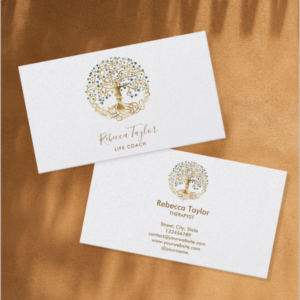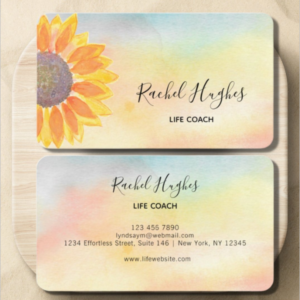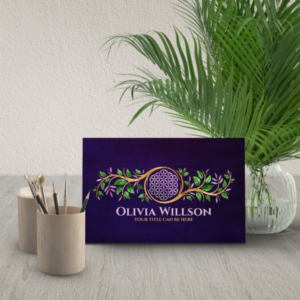Choosing the right life coach business card template is essential, and the process involves several key factors, from layout and design to the content you include.
When you’re a life coach, your business card is often the first impression you make on potential clients. It serves as a compact yet powerful branding tool that reflects your expertise, values, and professionalism.
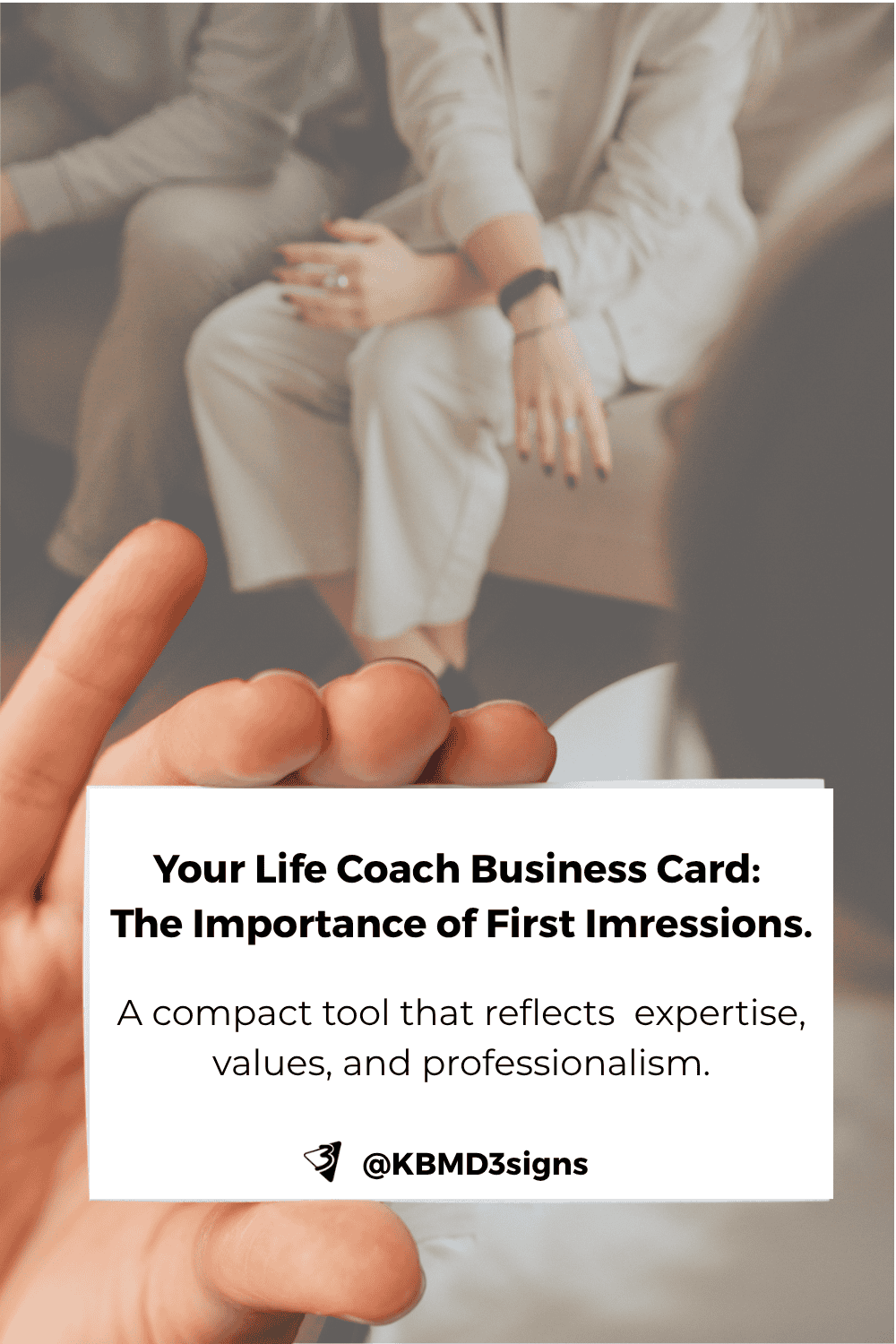
In this article, we’ll guide you through how to select the best template, and the impact of design choices like layout (portrait vs. landscape), the inclusion of profile photos or logos, and what vital information to include.
Article Content:
- Business Card: Choosing the Right Layout: Portrait vs. Landscape
- The Impact of Content: What to Include on Your Life Coach Business Card
- Company Business Card or Personal Business Card?
- Additional Considerations for Life Coach Business Cards
- Color, Its Role In A Life Coach Business Card
- Life Coach Business Card Template Designs by KBM D3signs
- Inspired by Nature – Color Collages
- Offline Marketing Items Essential to a Life Coach
- Frequently Asked Questions about Life Coach Business Cards
1. Business Card: Choosing the Right Layout: Portrait vs. Landscape
One of the first decisions to make when selecting a business card template is the card’s layout. The two most common orientations are portrait and landscape, each offering its own aesthetic and functional advantages.
- Portrait Layout: This vertical design can create a sleek and modern look. It allows for more creative use of space, making it a good choice if you want to stand out. Portrait cards can be effective for life coaches looking to emphasize personal branding, perhaps showcasing a professional headshot or a tagline that encapsulates their coaching philosophy. The portrait layout is also often associated with individual branding, which makes it ideal for personal business cards.
- Landscape Layout: This is the more traditional, horizontal orientation, and is commonly associated with professionalism and clarity. The landscape layout offers ample space for more detailed content like your full name, title, business name, logo, and contact information. If your goal is to create a clean, organized look that focuses on your services and expertise, this layout is often a better fit. Landscape is also a great choice for company business cards.
2. The Impact of Content: What to Include on Your Life Coach Business Card
The content you include on your business card is crucial for establishing credibility and making sure potential clients can easily reach out to you. Here’s what to consider:
- Profile Photo: Including a professional photo of yourself can add a personal touch, especially in a people-centered field like life coaching. A photo humanizes your brand, making it easier for clients to connect with you emotionally. However, this works best if you opt for a portrait layout, as space may be limited in a landscape design. If you prefer a sleek, minimalist aesthetic, you might want to leave out the photo and let other elements (like a logo) speak for you.
- Initials as a Decorative Element or Logo: Some life coaches use their initials or a unique emblem as part of their branding, which can make a strong visual impact. This approach allows for a minimalistic yet professional design. Incorporating initials as a logo creates a sense of personal branding and is ideal if you are a sole practitioner. If you’re looking to grow your business into a larger coaching firm, however, a more traditional company logo might better suit your goals.
- Business Name or Personal Name: Decide whether you want the card to focus on your individual name or your business name. If you’re a personal coach with a strong personal brand, your name should take precedence. On the other hand, if you’re establishing a coaching company with multiple coaches, prioritize the company name to build broader brand recognition.
- Tagline or Motto: Adding a short, impactful tagline can instantly communicate your coaching style or philosophy. Something like “Empowering You to Achieve More” or “Find Clarity, Create Success” can reinforce your unique value proposition and stick with potential clients.
- Contact Information: This is the most critical part of your business card. Be sure to include:
– Full name or company name
– Title (Life Coach, Executive Coach, Wellness Coach, etc.)
– Phone number and email address
– Website URL or social media handles (LinkedIn, Instagram)
– Office address (if applicable)
– QR code (optional): If you want to direct clients to a landing page, blog, or booking calendar, a QR code can be an effective addition to your card without overcrowding it with text.
3. Company Business Card or Personal Business Card?
Determining whether your card should reflect a company or a personal brand depends on your business model.
- Personal Business Card: If you’re a solo life coach, the focus will likely be on your personal brand. Your name, photo, tagline, and contact details will take center stage. You might want to include a subtle logo or use creative design elements like your initials to enhance the look. Personal cards are generally more intimate, which works well if you want clients to feel connected to you directly as their coach.
- Company Business Card: If you’re operating a life coaching firm with a team of coaches, the business card will likely reflect the broader brand. In this case, the design should include the company logo, the firm’s tagline, and consistent branding elements (fonts, colors) that align with your company’s identity. You might not need a personal photo on this type of card, and the focus will shift to services, professionalism, and perhaps a QR code that links to your team’s profiles.
4. Additional Considerations for Life Coach Business Cards
- Colors and Fonts: Colors convey emotions and brand values. Soft pastels or earth tones can evoke calmness and serenity, aligning with coaching themes like mindfulness and balance. Bold colors like navy, gold, or deep purple can reflect authority and professionalism, perfect for executive coaches. Ensure that your font is easy to read; a sans-serif font works well for modern designs, while serif fonts evoke a more classic, traditional vibe.
- Paper Stock and Finish: The feel of your business card is just as important as how it looks. High-quality paper stock shows you take your business seriously. A matte finish can offer a soft, approachable feel, while a glossy finish gives the card a polished, professional look. Consider embossing or raised lettering for added elegance, particularly if you’re presenting yourself as a premium service.
- Minimalism vs. Detail: Some life coaches prefer to keep their cards minimalist, focusing only on essential information. This design style can suggest simplicity, clarity, and focus—qualities many clients seek in a coach. However, more detailed cards, including contact info, tagline, and multiple social media handles, can convey that you are highly accessible and offer diverse ways to engage with your services.
All in all, choosing the right life coach business card template involves more than just picking a pretty design. Every choice, from layout and logo to font and paper stock, communicates something about your brand. Whether you opt for a portrait or landscape orientation, a personal or company-focused design, or minimalist vs. detailed content, your business card should reflect who you are as a coach. It’s more than just contact information; it’s a statement about the kind of guidance and impact you offer your clients.
5. Color, Its Role In A Life Coach Business Card
Color plays a crucial role in the design of a life coach business card, as it not only affects the visual appeal but also conveys key elements of your brand personality, values, and the emotions you want to evoke in your clients. Since life coaching is deeply personal and rooted in creating trust, choosing the right colors can help align your branding with your coaching style, attract the right clients, and set the tone for your services.
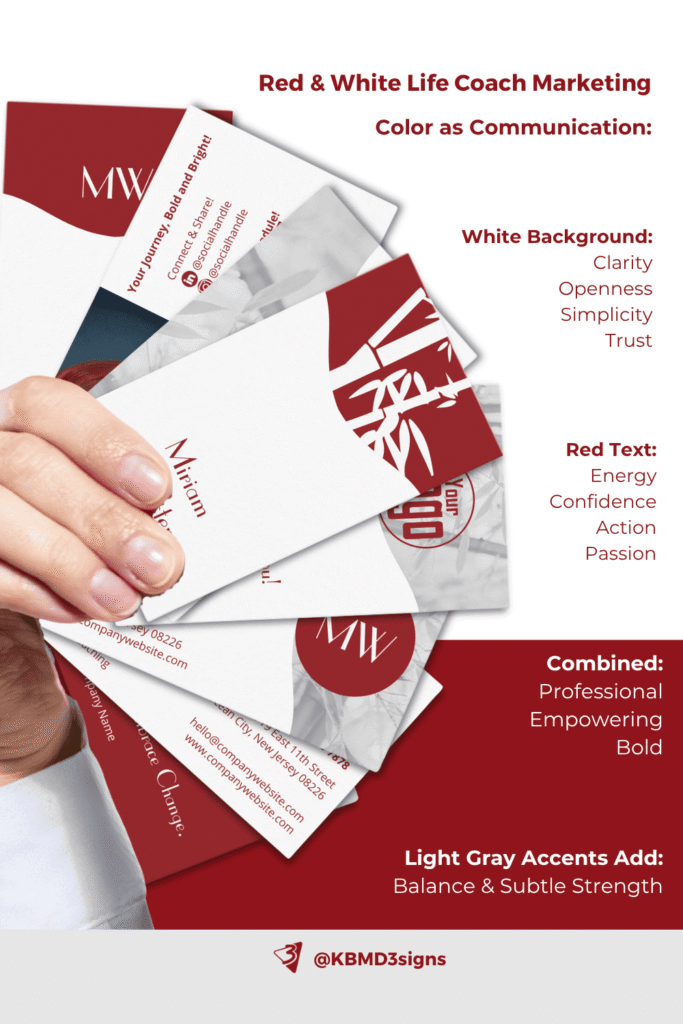
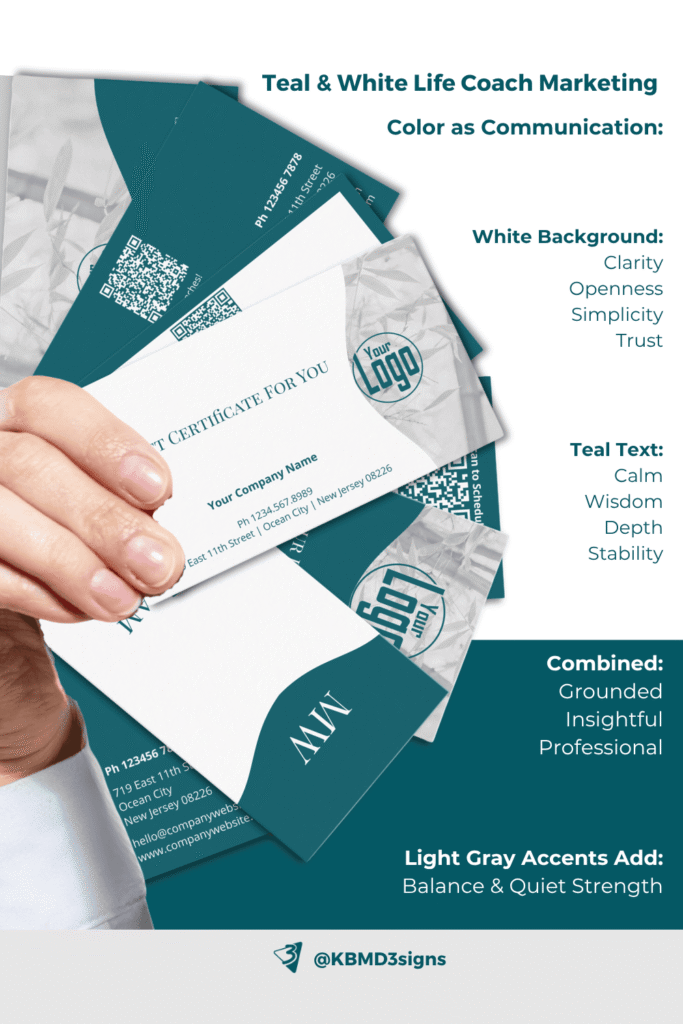
Here’s a breakdown of how color influences your business card and the role it plays in making an impactful first impression:
5-1. Communicating Brand Personality and Values
Colors are closely tied to emotions and perceptions, and each color carries its own psychological significance. When choosing the color palette for your life coach business card, it’s important to think about how the colors reflect your brand personality and values:
Blues:
Often associated with trust, professionalism, and calmness. Life coaches who focus on areas like emotional intelligence, corporate or executive coaching, or mental clarity often use shades of blue to instill confidence and dependability.
Greens:
This color is linked to growth, harmony, and balance, making it perfect for life coaches focused on wellness, mindfulness, or personal development. It also evokes feelings of renewal and positivity, aligning well with transformational coaching themes.
Purples:
Known for evoking a sense of wisdom, spirituality, and luxury, purple can work for life coaches who specialize in areas like self-actualization, spiritual growth, or personal empowerment. It’s often used to indicate high-level or niche coaching services.
Yellows and Oranges:
These warm colors represent optimism, energy, and positivity. They are well-suited for life coaches who focus on motivation, goal-setting, and boosting clients’ confidence. These colors create a sense of approachability and creativity.
Neutrals (Gray, White, Beige):
Neutrals communicate professionalism, simplicity, and clarity. If you want your business card to feel minimalistic and modern, a neutral palette helps achieve that while letting other design elements (like logos or text) take center stage.
Reds:
This is a bold color that evokes passion and urgency. While not commonly used in life coaching cards, it could work for coaches who specialize in high-energy fields like fitness, motivation, or leadership, where creating a sense of action and drive is essential.
⇒ Learn more about “How to Choose Brand Colors”
5-2. Creating Emotional Connections
The emotional impact of color can deeply influence a potential client’s first impression of you. Since life coaching often involves personal growth, self-discovery, and emotional healing, choosing colors that resonate with those themes can help create an emotional connection even before a conversation takes place.
- Calming Colors: Softer tones like light blues, pastel greens, or gentle pinks evoke tranquility, peace, and care. These colors are ideal if your coaching focuses on stress management, self-care, or overcoming anxiety.
- Energizing Colors: Brighter shades like yellow or orange can boost feelings of positivity, motivation, and hope. If your coaching involves personal empowerment or motivation, these colors can subconsciously inspire action.
- Trust and Stability: Darker shades like navy blue, dark gray, or black suggest reliability, professionalism, and authority. If you’re an executive or leadership coach, these colors help position you as a credible and experienced expert.
5-3. Differentiating Your Brand
In a crowded coaching market, color can help you stand out and differentiate your brand from other life coaches. A well-thought-out color scheme can make your business card visually distinctive, leaving a lasting impression on potential clients. For example:
- Bold Colors: If you want to stand out at networking events or conferences, bold, eye-catching colors like vibrant oranges, deep purples, or bright blues can create a visual pop.
- Unique Color Combinations: Combining complementary or contrasting colors (such as teal with gold accents or purple with white) can make your card feel dynamic while showcasing your unique approach to coaching.
5-4. Building a Cohesive Brand Identity
Your business card is one element of your overall brand identity, and the colors you choose should align with your website, social media profiles, and other marketing materials. This consistency helps clients recognize and remember your brand. For example:
- If your website has a calming, neutral palette, your business card should reflect that same aesthetic to maintain visual harmony.
- If your coaching brand is vibrant and motivational, using bold, energetic colors across all marketing platforms, including your business card, strengthens that identity.
5-5. Setting the Tone for Your Services
The colors on your life coach business card also help set expectations about the type of coaching you provide. Clients form immediate impressions based on the card’s appearance, so the right colors can set the tone for your sessions:
- Serene Colors for Therapeutic Coaching: If you specialize in holistic wellness, stress management, or mindfulness, colors like soft blues, greens, and lavender will communicate tranquility and healing.
- Bold Colors for High-Energy Coaching: If your coaching focuses on high-performance, career advancement, or leadership, vibrant colors like red, orange, or gold can suggest dynamic energy and ambition.
- Neutral Tones for Professional or Corporate Coaching: If your target audience is executives or professionals, a more restrained palette of black, white, and grays will convey professionalism and seriousness.
5-6. Appealing to Your Target Audience
When choosing colors, consider the demographics and psychographics of your target audience:
- Younger Audience: Bright, bold colors like electric blue, pink, or lime green may appeal to younger clients who are drawn to modern, energetic designs.
- Corporate Clients: Darker tones like navy blue, charcoal, or burgundy are more likely to resonate with a corporate or executive audience, reflecting professionalism and trustworthiness.
- Holistic or Spiritual Audience: Soft pastels, earth tones, and muted colors like sage green, beige, or light purple can attract clients who are focused on mindfulness, meditation, or spiritual growth.
5-7. Cultural Significance of Colors
Different colors carry various meanings across cultures. If you’re working with an international or multicultural audience, it’s important to consider how your color choices might be perceived:
- White: In many cultures, white represents purity and new beginnings, which aligns well with life coaching. However, in some cultures, it symbolizes mourning.
- Yellow: Often associated with positivity and joy in Western cultures, but it can also signify caution or uncertainty in some regions.
Overall, color is a powerful tool in life coach business card design, playing an important role in defining your brand, creating emotional connections, and engaging your target audience. The right color palette can enhance the impact of your business card by aligning it with your coaching philosophy and the emotions you want to evoke in potential clients. By carefully selecting colors that reflect your brand personality, values and target audience, you can make your business card an important offline marketing tool that leaves a lasting, positive impression.
6. Life Coach Business Card Template Designs by KBM D3signs
At KBM D3signs, our mission is to provide outstanding marketing materials that help life coaches create a strong, memorable brand presence. Our latest collections reflect this commitment, offering versatile and customizable business card designs tailored to meet the unique needs of life coaches.
Here are two standout collections:
Deep Red and White Theme
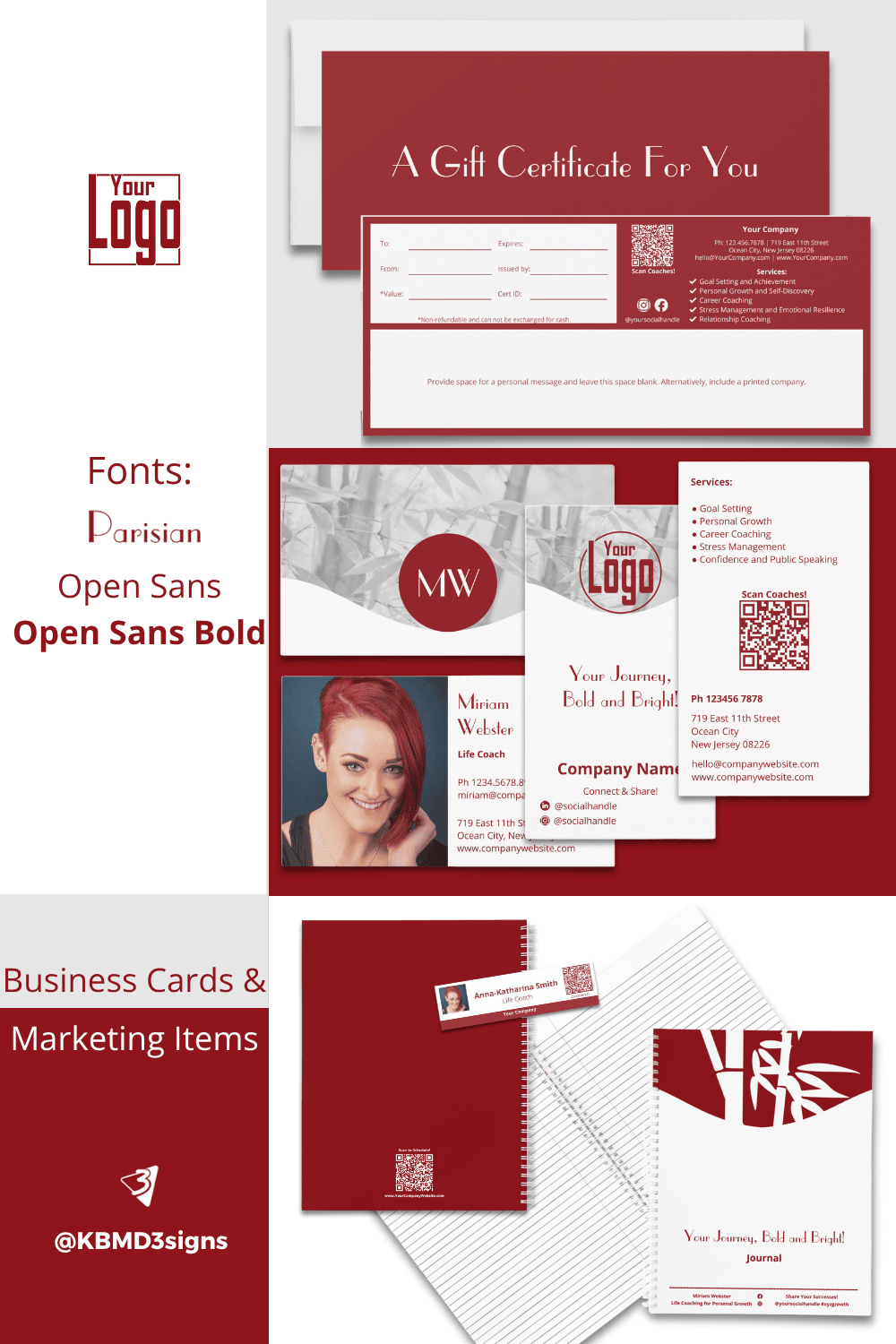
Primary Color: Deep Red (#8f141b)
Font Combination: Open Sans (for body text), Open Sans Bold (for titles and accents), and Parisian (for taglines and names where suitable).
This collection is bold and professional, using a rich red that conveys passion, confidence, and determination. The white accents balance the intensity, ensuring clarity and readability. The Open Sans font, known for its clean lines, is perfect for maintaining professionalism, while Parisian adds an elegant, decorative touch to taglines and names.
Design elements include a decorative black and white bamboo photo with a 50% transparent overlay to soften the effect. For more minimalist options, a bamboo silhouette graphic in white adds subtle sophistication.
⇒ Explore the collection: “Life Coach Red & White Branding Package“
Teal and White Theme
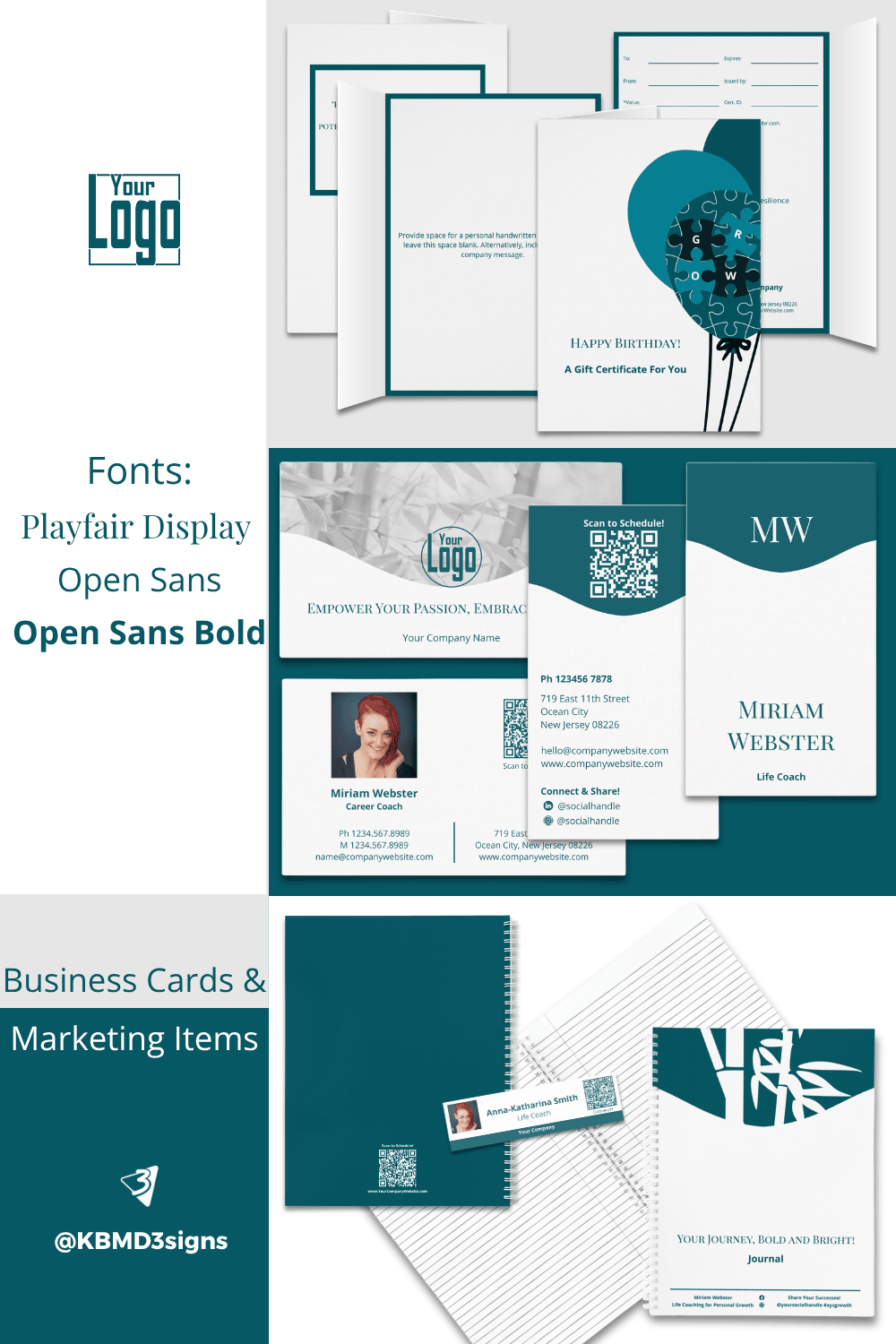
Primary Color: Teal (#055864)
Font Combination: Open Sans (for body text), Open Sans Bold (for titles and accents), and Playfair Display (for taglines and names where appropriate).
The teal theme brings a sense of calm, balance, and renewal, perfect for life coaches who focus on personal growth and wellness. Paired with white, it creates a refreshing, clean aesthetic. Playfair Display, with its classic elegance, adds a sophisticated touch and contrasts beautifully with the modern simplicity of Open Sans.
This collection also features black-and-white bamboo photo elements softened by a 50% overlay and minimalistic designs that focus purely on color and typography for a sleek, contemporary look.
⇒ Explore the collection: “Life Coach Teal & White Branding Package“
Personalization Options and Additional Features
Our business card collections cover all types of needs:
These designs provide flexibility for coaches who want a professional yet personalized touch. The inclusion of QR codes enhances usability, offering an easy way for clients to connect via a simple scan.
Customization Made Easy
At the Cocoon It! Store by KBM D3signs on Zazzle, we empower you to define your brand identity through a range of customizable business card templates. For optimal contrast the QR code’s second color is either black or white.
You can edit almost every element using the “Edit using Design Tool” button, ensuring your business card perfectly aligns with your unique branding.
To aid in this process, learn about the color tools we use. You can also find curated color palette ideas for inspiration. The customization doesn’t stop at placeholders—every element is flexible and can be adjusted to reflect your personal style.
If you need additional assistance customizing or transferring designs to different products, or if you have a unique vision that requires a custom design, we are just a message away.
Show off your personal style or post a review!
7. Inspired by Nature – Color Collages
These nature-inspired palette images—muted reds dancing on reflective water, festive holly berries, dramatic mountain light, and harmonious dolphins—showcase how the colors #8F141B and #055864, when paired with crisp white and soft grays, can evoke a sense of seasonal richness, emotional clarity, grounded stability, and subtle depth. The collages demonstrate the depth and harmony of our color palette and incorporate possible accent colors that enhance the brand’s aesthetic.
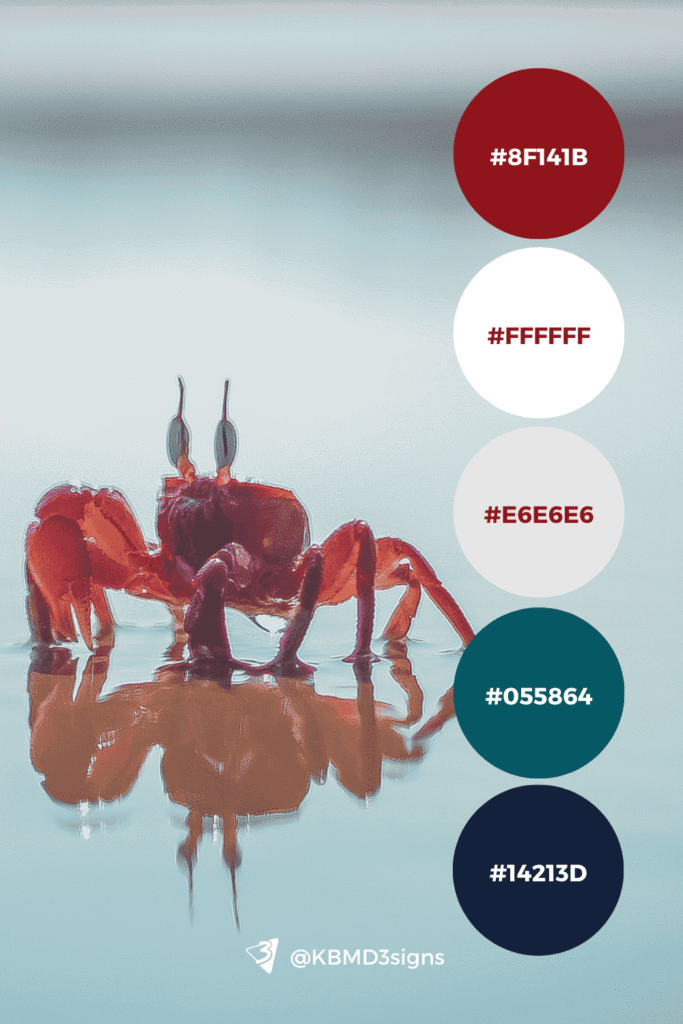
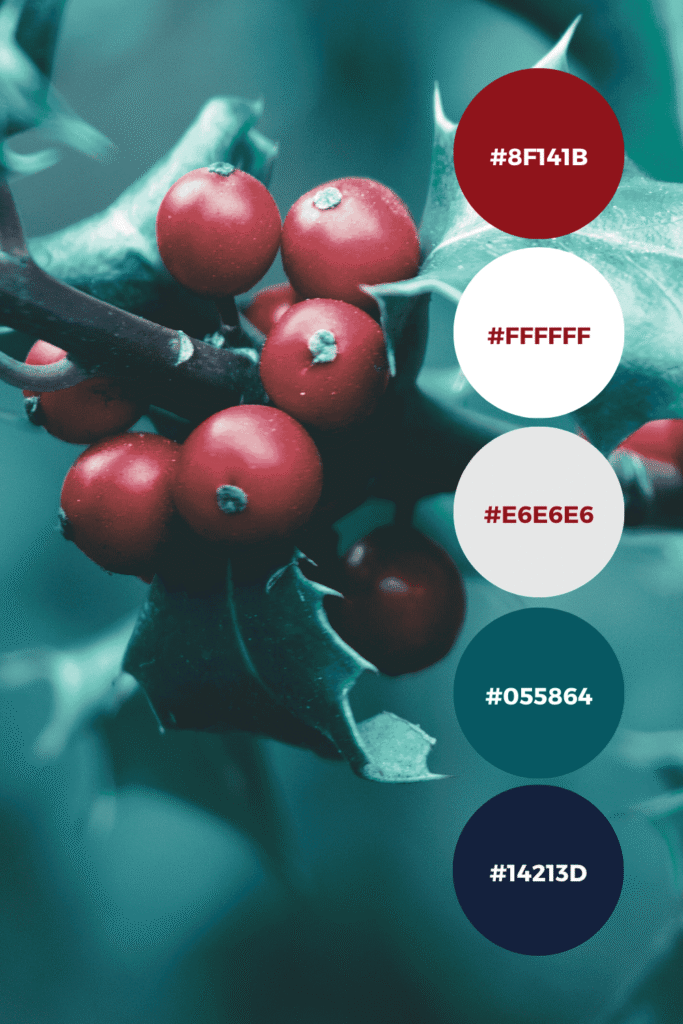
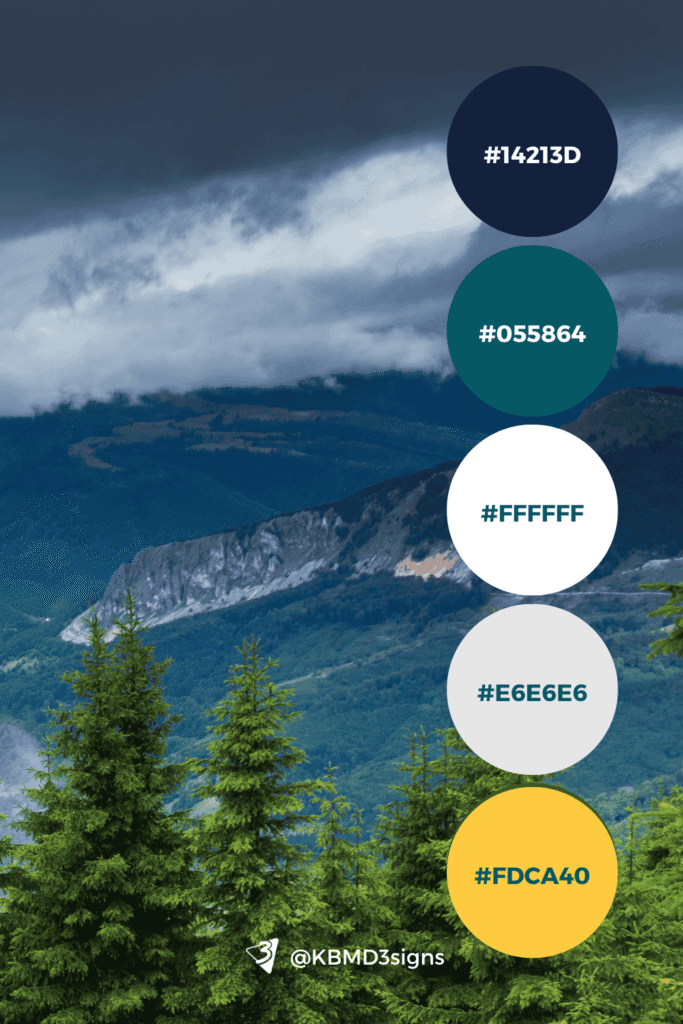
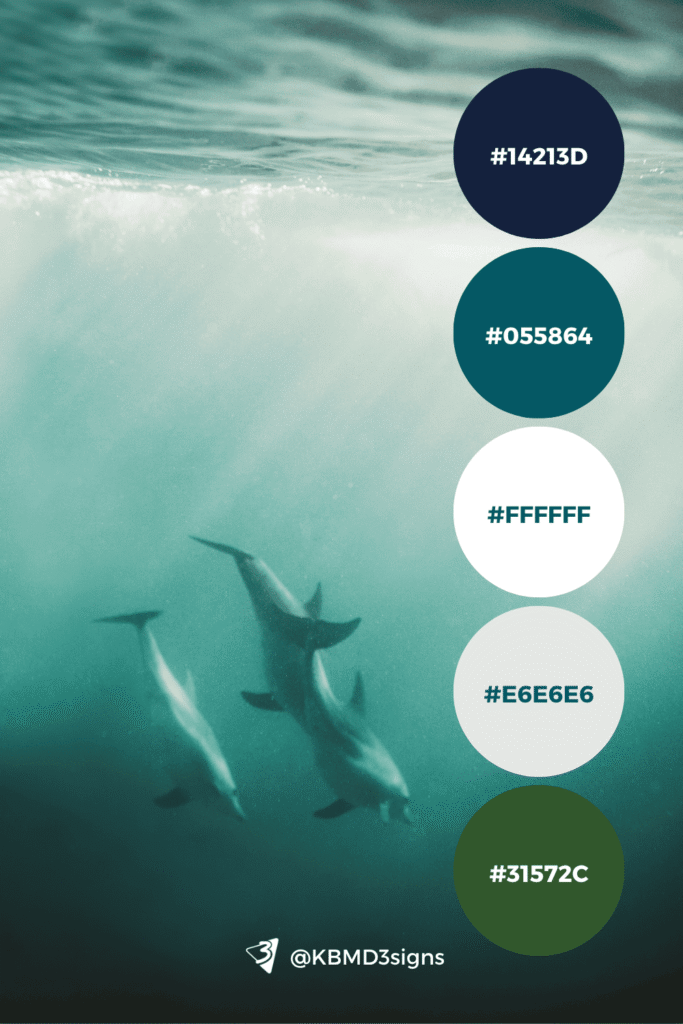
8. Offline Marketing Items Essential to a Life Coach
In today’s digital age, many life coaches focus on online marketing to grow their businesses. However, offline marketing still plays a critical role, especially for coaches looking to build deeper, personal connections within their community or reach clients who value tangible interactions. Below are the essential offline marketing items every life coach should consider to strengthen their presence and grow their client base.
8-1. Business Cards
A business card is a must-have for any life coach. It’s your portable introduction to potential clients and professional contacts. Make sure your business card is a high-quality reflection of your brand, containing:
Your business card serves as an essential networking tool, helping you make a memorable first impression at events, conferences, or local gatherings.
8-2. Brochures or Flyers
Brochures or flyers allow you to provide more detailed information about your coaching services than a business card can. These can be handed out at:
- Networking events
- Health and wellness expos
- Local businesses (gyms, yoga studios, coffee shops)
- Counseling centers or holistic health centers
A well-designed brochure should include:
- A brief bio and your qualifications
- An overview of your services (1-on-1 coaching, group coaching, workshops, etc.)
- Success stories or testimonials from past clients
- Contact information and how to book a consultation
These materials can be particularly useful for coaches who work locally and want to spread awareness within their community.
8-3. Appointment Cards
If you have in-person clients, appointment cards are an excellent way to ensure your clients remember their upcoming sessions. These small, handy cards can also include your contact information, serving a dual purpose as a business card. Plus, appointment cards can increase client retention by keeping them organized and accountable.
8-4. Branded Stationery
Branded stationery, including letterheads, envelopes, and notepads, helps you establish a professional and cohesive brand image. Sending thank-you notes, invoices, or personalized follow-ups on custom stationery demonstrates attention to detail and can leave a lasting impression on clients.
- Notepads branded with your logo can be given as freebies to clients or during workshops, which keeps your brand visible.
- Personalized thank-you cards can be sent to clients after their first session or completion of a coaching program. Handwritten notes go a long way in building rapport and client loyalty.
8-5. Posters or Banners
For life coaches who participate in seminars, workshops, or public speaking events, a poster or banner is essential for promoting your services and capturing attention. Having a well-designed, eye-catching banner will make your booth or presentation space stand out at events like:
- Health fairs
- Career counseling seminars
- Personal development workshops
Include your logo, a brief tagline, and your contact details on the banner to ensure people can connect with you even after the event.
8-6. Promotional Merchandise
Promotional items can enhance your offline marketing efforts by offering a tangible reminder of your services. Consider giving away small, useful items like:
- Pens or notebooks with your logo
- Tote bags or water bottles with motivational quotes and branding
- Bookmarks that include a coaching tip or inspirational message along with your contact info
- Magnetic Calendar, people often refer to calendars for scheduling, and having your brand associated with an essential tool can create a lasting impression.
These items keep your brand top of mind and may even serve as conversation starters when used in public.
8-7. Printed Testimonials or Case Studies
Trust and credibility are crucial in life coaching. Printed testimonials or case studies can help build that trust by demonstrating your impact. Compile a small booklet or sheet with stories of clients you’ve helped (with their consent) and distribute these at events, workshops, or consultations. Personal stories resonate deeply and can inspire potential clients to work with you.
8-8. Referral Cards
Word-of-mouth is one of the most powerful forms of marketing, and referral cards can help encourage your clients to recommend you to others. You can offer a discount or a free session for both the referring client and the new client. These cards can be handed out after sessions or included in a welcome package for new clients.
8-9. Workbooks and Journals
For life coaches who run workshops or seminars, providing attendees with workbooks or journals adds tremendous value. These items allow participants to actively engage with the material and keep your brand visible even after the event ends.
- Custom-designed journals or guided workbooks can feature your coaching tips, exercises, or reflections.
- Offer them for sale or as part of your coaching packages, ensuring clients have a practical tool to work on their personal growth outside of sessions.
8-10. Gift Certificates or Vouchers
Offering gift certificates or vouchers for coaching sessions is a fantastic way to encourage referrals and attract new clients. Clients can buy them for friends or family members, serving as both a thoughtful gift and a powerful word-of-mouth marketing tool.
Gift certificates work well during holidays or special occasions, like New Year’s. People are then more focused on personal development and goal-setting.
8-11. Direct Mail Campaigns
For coaches targeting a local or niche audience, direct mail can be an effective strategy. Sending personalized postcards or letters with special offers (like a free consultation or discounted first session) to a curated list of recipients can yield excellent results. Ensure that your mailing is visually appealing, professionally printed, and has a clear call to action.
Overall, offline marketing remains a powerful tool for life coaches, complementing your digital marketing efforts by helping you build personal connections and credibility. From business cards and brochures to branded stationery and promotional items, these essential offline marketing tools can help you create a memorable brand experience, attract new clients and retain existing ones. Combining these items with a clear and consistent brand message will help you stand out from the crowd and solidify your presence as a trusted life coach.
-

Reflecting on Small Business Marketing as 2024 Draws to a Close
Read the post …: Reflecting on Small Business Marketing as 2024 Draws to a Close -
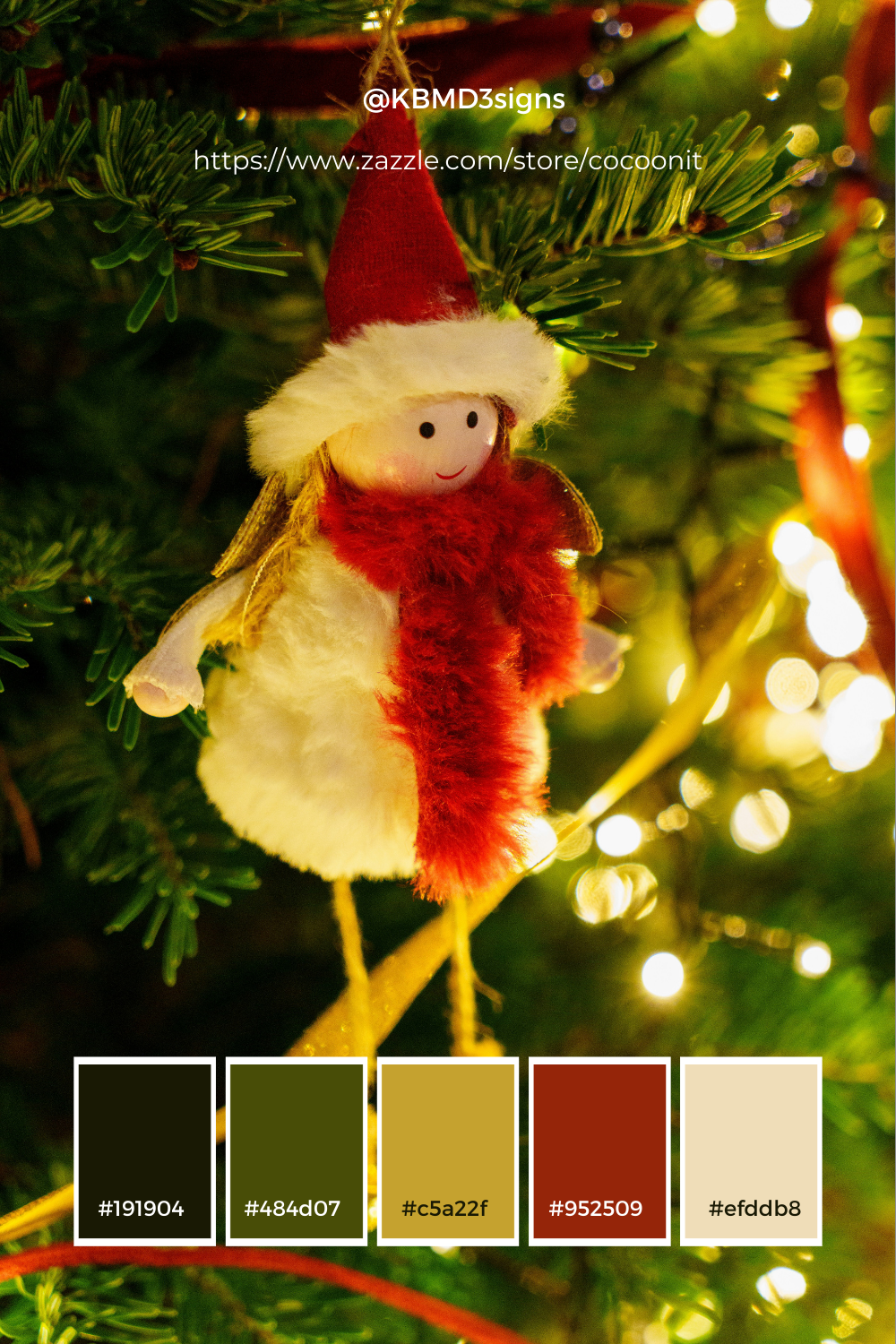
Why Christmas Colors Matter & How To Incorporate Brand Colors
Read the post …: Why Christmas Colors Matter & How To Incorporate Brand Colors -
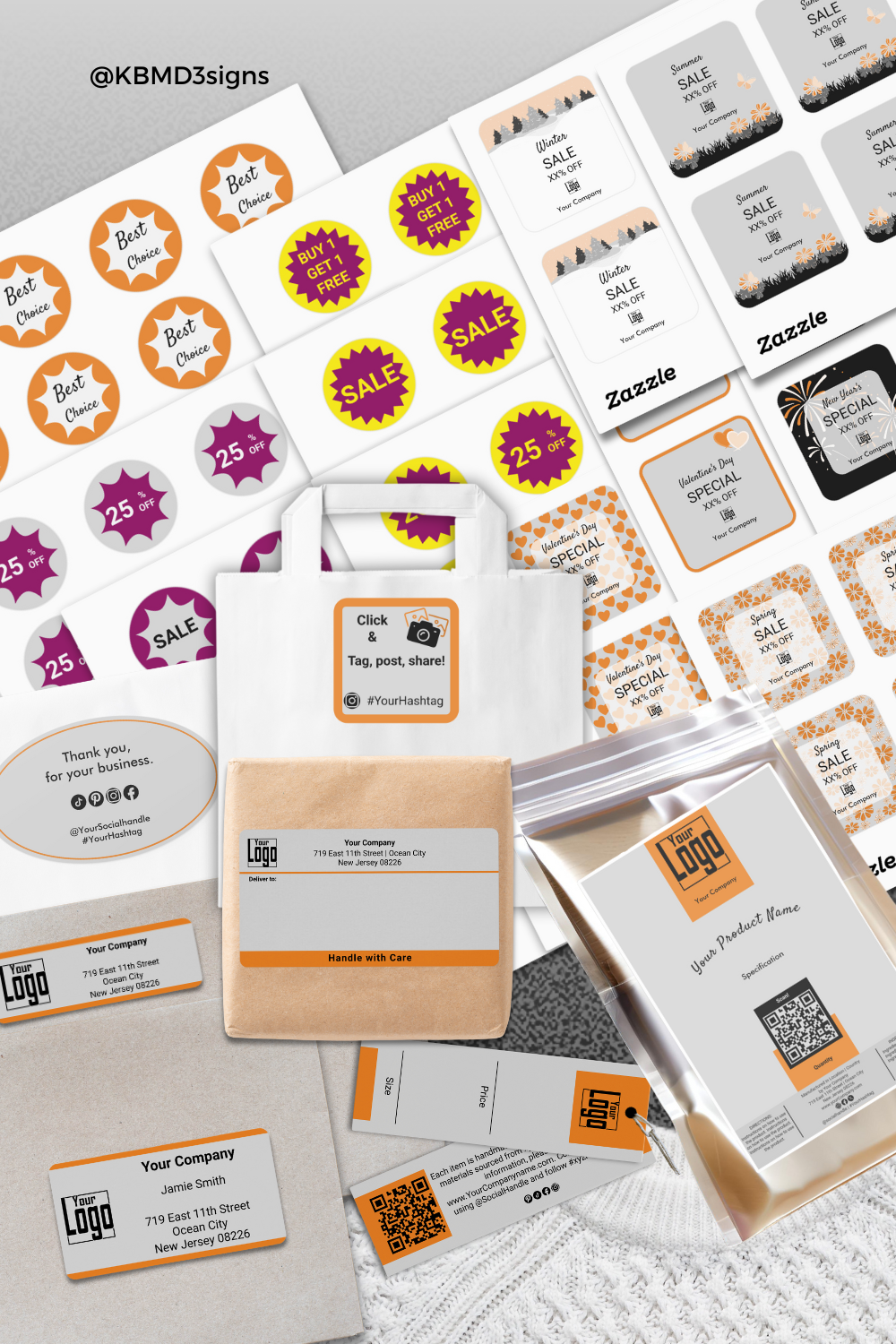
What Are Labels? Big Impact: Transforming Brand Perception
Read the post …: What Are Labels? Big Impact: Transforming Brand Perception
8. Frequently Asked Questions about Life Coach Business Cards
Your life coach business card should contain all essential information to help potential clients connect with you.
This includes:
– Your full name
– Title (e.g., Life Coach, Executive Coach, Wellness Coach)
– Contact information (phone number, email, website)
– Social media handles (LinkedIn, Instagram, etc.)
– Logo or personal branding elements (if applicable)
– A short tagline or motto that reflects your coaching philosophy
– Optional: A QR code that links to your website or booking platform
Including a professional headshot on your business card can help humanize your brand and foster an emotional connection with potential clients. A photo works especially well in a people-centered profession like life coaching. However, if you prefer a more minimalist design or want to focus on company branding, you can opt for a logo or other branding elements instead of a photo.
The choice between portrait (vertical) or landscape (horizontal) layout depends on your branding style and design preference:
– Portrait Layout: Often seen as modern and unique, portrait cards can help you stand out, especially if you want to include a headshot or creative design elements.
– Landscape Layout: This is the more traditional orientation and allows more space for contact details, logos, and other information. It’s ideal if you want a clean, organized look.
Using initials or a logo depends on your branding goals:
– Initials: This approach works well for a personal brand and offers a minimalistic yet professional look.
– Logo: If you are building a coaching firm or want to create a more formal business identity, using a full logo can give your business a more polished and corporate feel.
Yes, including a tagline is a great way to communicate your coaching philosophy or unique selling proposition in a few words. For example, a tagline like “Helping You Unlock Your Full Potential” gives potential clients a clear idea of what you offer. Keep it short and impactful, so it doesn’t clutter the design.
The feel of your business card is just as important as the design. Opt for a high-quality paper stock to convey professionalism. Common options include:
– Matte Finish: Provides a soft, non-glossy look that can feel modern and understated.
– Glossy Finish: Gives the card a polished and professional appearance, which can make colors and designs pop.
– Textured Paper: Adds an element of sophistication and uniqueness, often used for premium brands.
To make your life coach business card stand out:
-Use high-quality paper and professional printing
– Choose a unique layout (portrait or square-shaped cards can be attention-grabbing)
– Incorporate a QR code linking to your website, booking platform, or testimonial page
– Use bold yet balanced colors that align with your brand
– Include an impactful design element, such as a logo, embossed text, or foil stamping
– Add a professional photo to personalize the card
Yes, including your social media handles is a smart way to give potential clients additional ways to connect with you. Platforms like LinkedIn, Instagram, or Facebook can showcase your expertise, testimonials, and success stories. Be selective about which social media accounts you include—only add those that are relevant to your professional life.
Absolutely. Using both sides of your business card maximizes the space and can create a more engaging design. For example:
– Front Side: Include your name, title, contact details, and logo or headshot.
– Back Side: Use it for a tagline, QR code, social media handles, or a brief list of services you offer.
This dual-sided approach helps keep the card clean and uncluttered while still providing essential information.
If you’re an independent life coach, a personal business card will suffice. However, if you run a coaching firm or have multiple coaches working under you, having a company business card that highlights the business name, logo, and services is ideal. You can also create a hybrid card that includes both your personal and company branding elements.
Color plays a significant role in branding, and the best scheme depends on the image you want to project:
– Soft pastels: Calm, approachable, and nurturing—ideal for coaches focused on wellness, mindfulness, or holistic coaching.
– Bold colors: Navy, gold, or deep purple evoke professionalism and authority, which works well for executive coaches.
– Earth tones: Natural greens, browns, and neutrals suggest balance and harmony, perfect for life or personal development coaches.
Choose a color scheme that aligns with your coaching style and brand values.
While printing at home may save money, using a professional printing service ensures higher quality in terms of paper stock, color accuracy, and finishing touches like embossing or foil stamping. A professionally printed card will leave a stronger impression and reflect your level of professionalism.
It’s a good idea to carry at least 20-30 business cards at all times. You never know when you’ll meet potential clients or networking contacts, so having a few readily available is always useful. For larger events or conferences, you might want to bring 50-100 cards to distribute widely.
Yes, digital business cards are becoming increasingly popular. You can use services or apps that allow you to share your contact details via QR codes, NFC, or email, eliminating the need for physical cards in some situations. However, it’s still beneficial to have physical business cards for face-to-face meetings or events where a personal touch is valued.
It’s a good idea to review and update your business card whenever there is a significant change in your business, such as:
– Rebranding (new logo or colors)
– Adding new qualifications or services
– Changing contact details (phone number, website, email)
– Expanding your social media presence
Additionally, you may want to refresh the design every couple of years to keep your card looking modern and aligned with current trends.
-

What Is A Brand Personality? – A Guide For Small Businesses
Read the post …: What Is A Brand Personality? – A Guide For Small Businesses -

What Is A Branding Strategy? – A Small Business Perspective
Read the post …: What Is A Branding Strategy? – A Small Business Perspective -
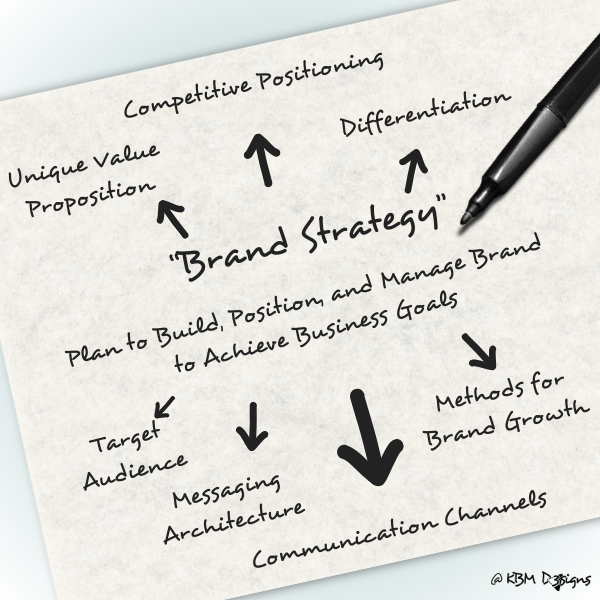
What Is A Brand Strategy? – Small Business Offline Objectives
Read the post …: What Is A Brand Strategy? – Small Business Offline Objectives



